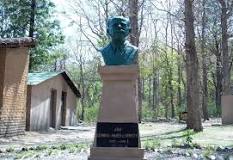Jim Corbett / (Colonel) Edward James
 Jim Corbett (25 July 1875–19 April 1955) was born at Nainital in 1875, eighth child of Christopher & Mary Jane Corbett. Jim Corbett's father was postmaster in Nainital. He did his matriculation at Nainital’s Philanders Smith College where he was admired by his masters for his modesty and retiring nature. He did not pursue his academics any further.
Jim Corbett (25 July 1875–19 April 1955) was born at Nainital in 1875, eighth child of Christopher & Mary Jane Corbett. Jim Corbett's father was postmaster in Nainital. He did his matriculation at Nainital’s Philanders Smith College where he was admired by his masters for his modesty and retiring nature. He did not pursue his academics any further.
Find Complete information on Jim Corbett Packages for Women & Girls in one of best Jim Corbett Resorts to stay within Jim Corbett where they can spend their time reading various Jim Corbett books on his hunting experience and do lots of adventure safari inside Jim Corbett. Book your Jim Corbett Tour through Official Jim Corbett Safari Booking website for Jim Corbett Hostels, Homestay & Hotels and also get information on Jim Corbett weather, how to reach Jim Corbett from Delhi and best time to visit Jim Corbett.
Jim Corbett spend his Summers at Gurni House in Nainital while in Winters he went down to Kaladhungi in tarai jungles. It was here Jim Corbett was taught how to fire a gun by his eldest brother. Their bungalow in Kaladhungi was inside dense forest in which a large variety of plants and animals found refuge. The abundance of wildlife in Nainital those days can be gauged from fact that Jim spotted tigers and leopards within a six and a half-kilometer radius of the temple of goddess Naini. As a result of living in such exotic and beautiful surroundings Jim Corbett developed a spontaneous affinity with nature.
At the tender age of ten he found himself addicted to hunting, Jim Corbett had shot his first leopard and would just pick up and train his gun on any wild animal he encountered in Jungle. When he was eighteen he joined railways at Mokama Ghat in Bihar working as fuel inspector and assistant station master. He then became a labour contarctor.
When World War I broke in 1914, he took batch of five hundred Kumaon labourers to France. He was good at recruiting and organizing labour and was able to make them work for him willingly. He also helped British government by training allied soldiers in jungle warfare, he then hold rank of lieutenant colonel. In 1920 after his health broke down he resigned from job and returned to Nainital and for next twenty-four years he served as an elected member of Nainital municipal Board.
While serving in railways at Mokama Ghat, he would spend his holidays at Kaladhungi. Shikar of course would claim most of his time, He had bagged two man eaters, a feat which made his name a house hold name in far flung areas and long before he was known as skilled jungle man leading Shikar parties for dignitaries. It was during one such Shikar parties with three army officers, turning point came in life of Jim. Once during Shikar party somewhere in northern India they came upon a lake with thousands of water fowls. They were delighted to see sight and shots rang echoing in entire valley. In a matter of minutes their count stood at three hundred or some waterfowls. Jim could not stomach this sacrilege. From that day he developed an aversion to this type of Shikar and while his friends were overjoyed Jim vowed never to kill a beast without a reason. After he had killed a man-eater known as Kuara of Pawalgadh in mid thirties he gave up Shikar as sport. There after he shot only those tigers which had turned man-eaters or cattle lifters.
Jim Corbett considered it his duty to kill such dangerous animals, a duty he carried out faithfully till his last day. He killed his last man-eater when he was well past sixty. In those days terror of Man-eaters loomed heavy on regions of Kumaon and Garwhal and Jim Corbett was only man who had guts to take on and kill such bloodthirsty beasts, endowed as he was with his superlative skills required for job he killed man-eaters in their den, in open grassland, in dense forest and on rocky slopes. Some of his most famous encounters are published in his six books of which the man-eaters of Kumaon and The Man Eating Leopard of Rudra Prayag are well renowned.
After World War II Jim Corbett settled in Kenya with his sister Maggie. It was there that at ripe age of eighty on 19 April 1955, Jim Corbett passed away leaving behind a legacy which still reverberate in valleys of Kumaon and Garwhal.
In all his years serving the cause of wildlife preservation and later deliverer of peace and tranquility in man eater infested regions of Kumaon and Garwhal Jim became inherent with wildlife conservation and Indian Government in 1956 renamed the park – Jim Corbett National Park in honour of Jim Corbett "Powerful Missionary for Wildlife Preservation in India. A fitting "Tribute to White Saint".
